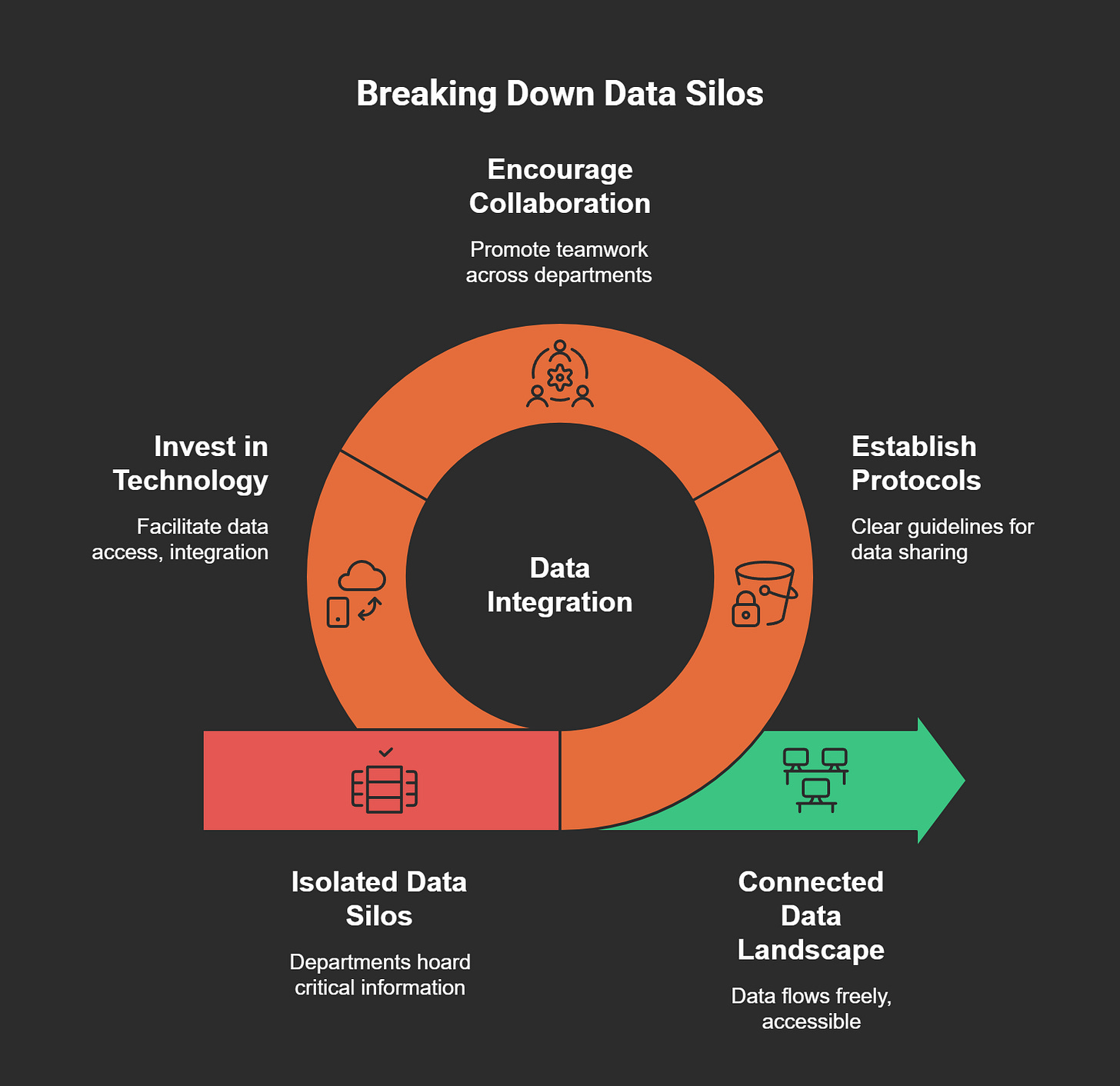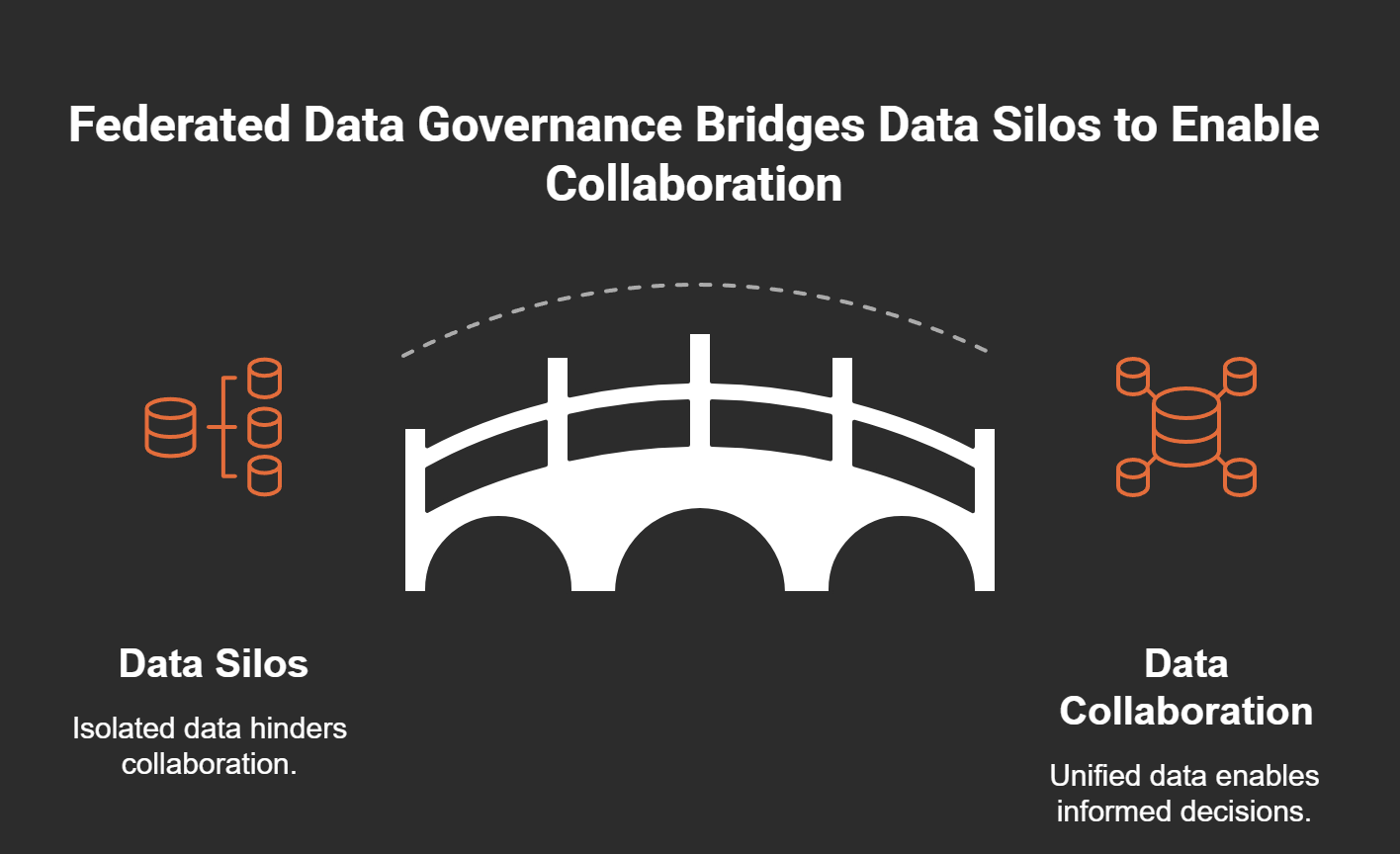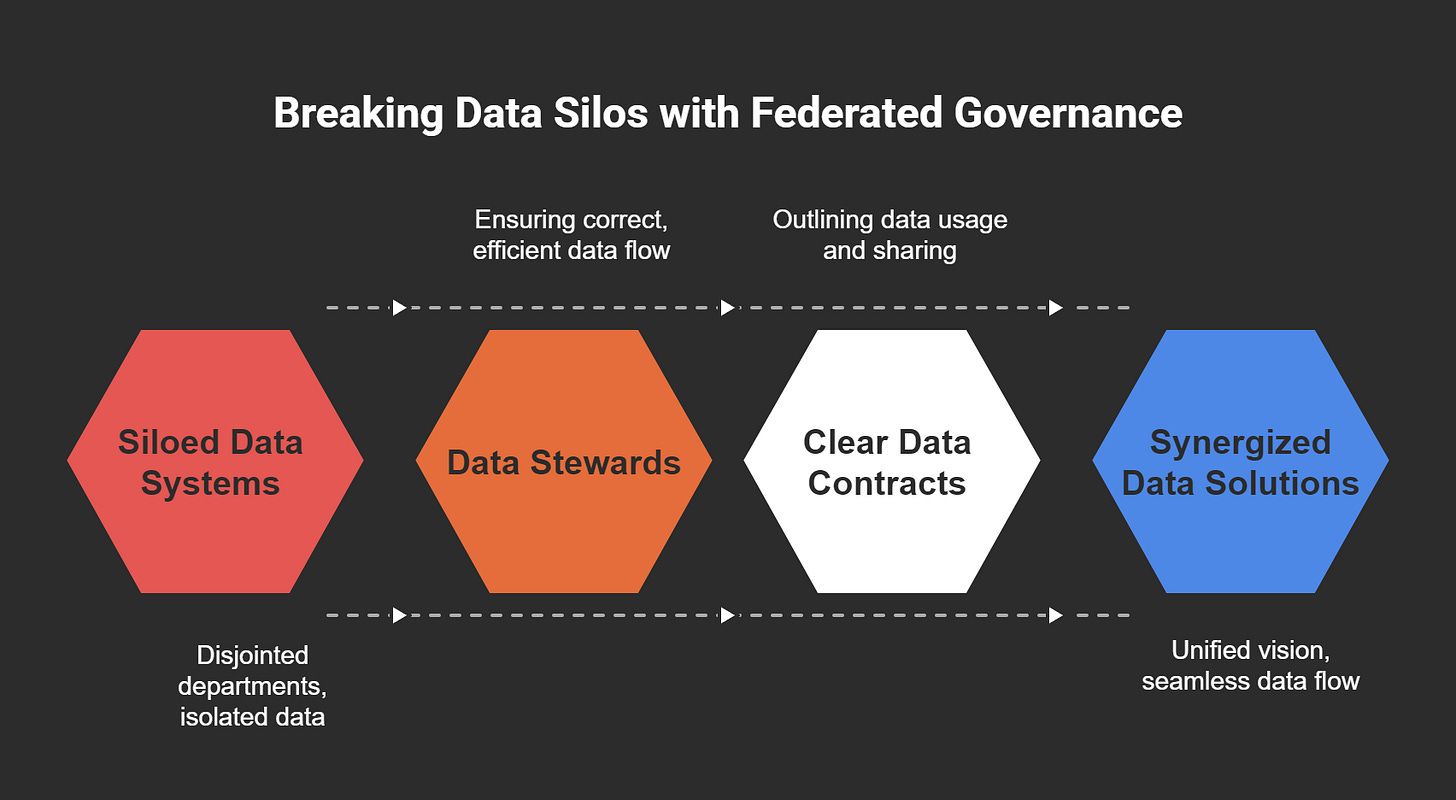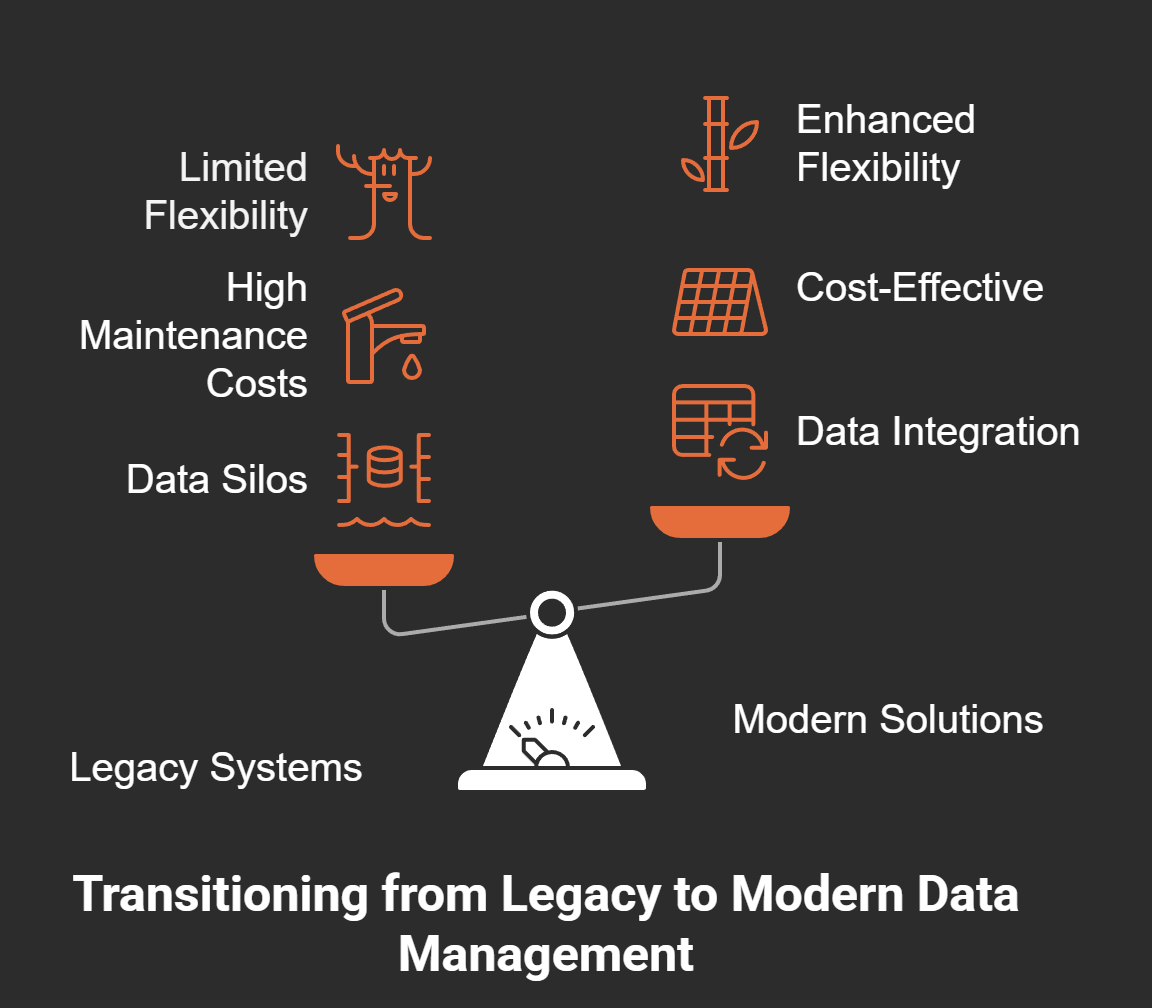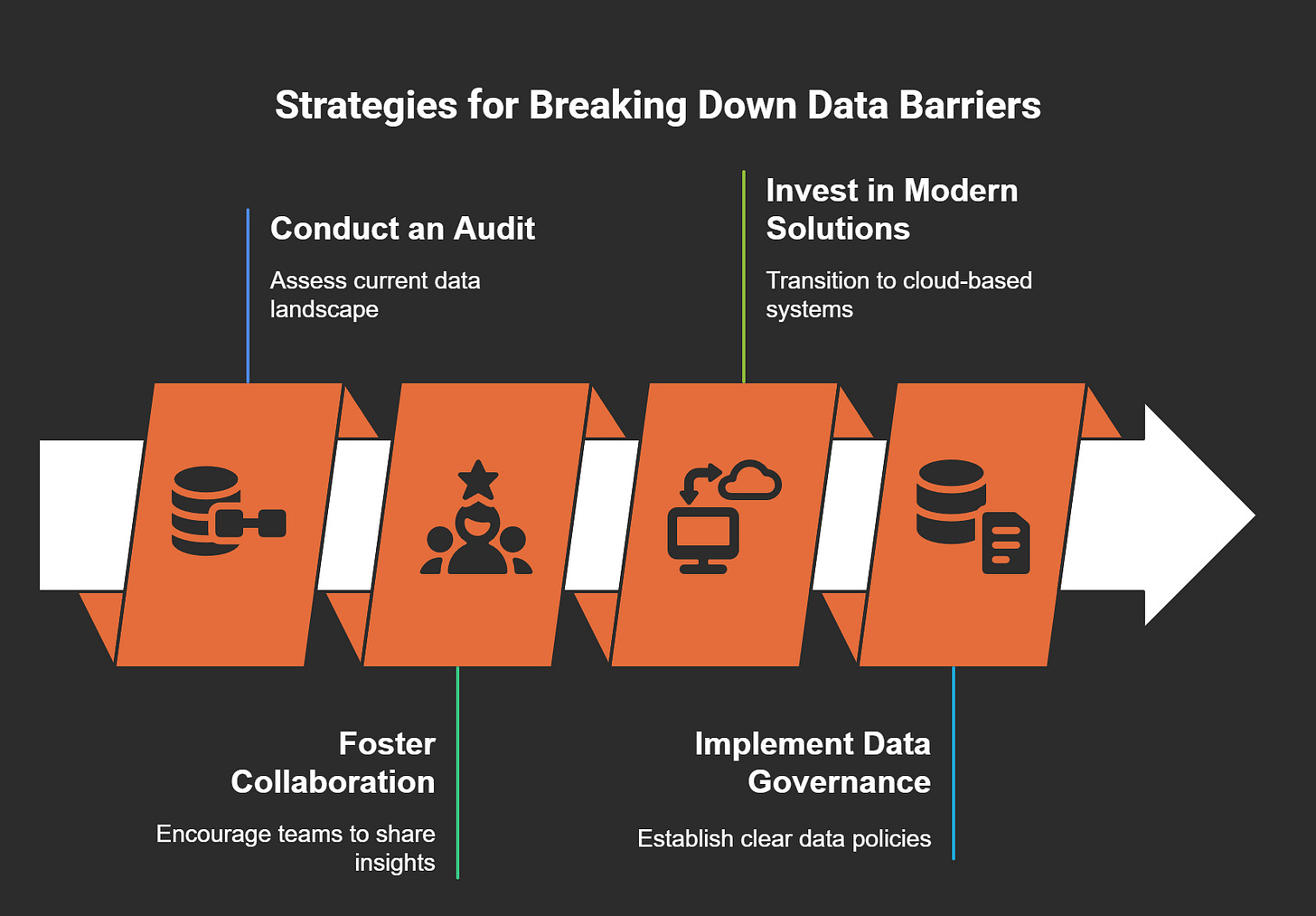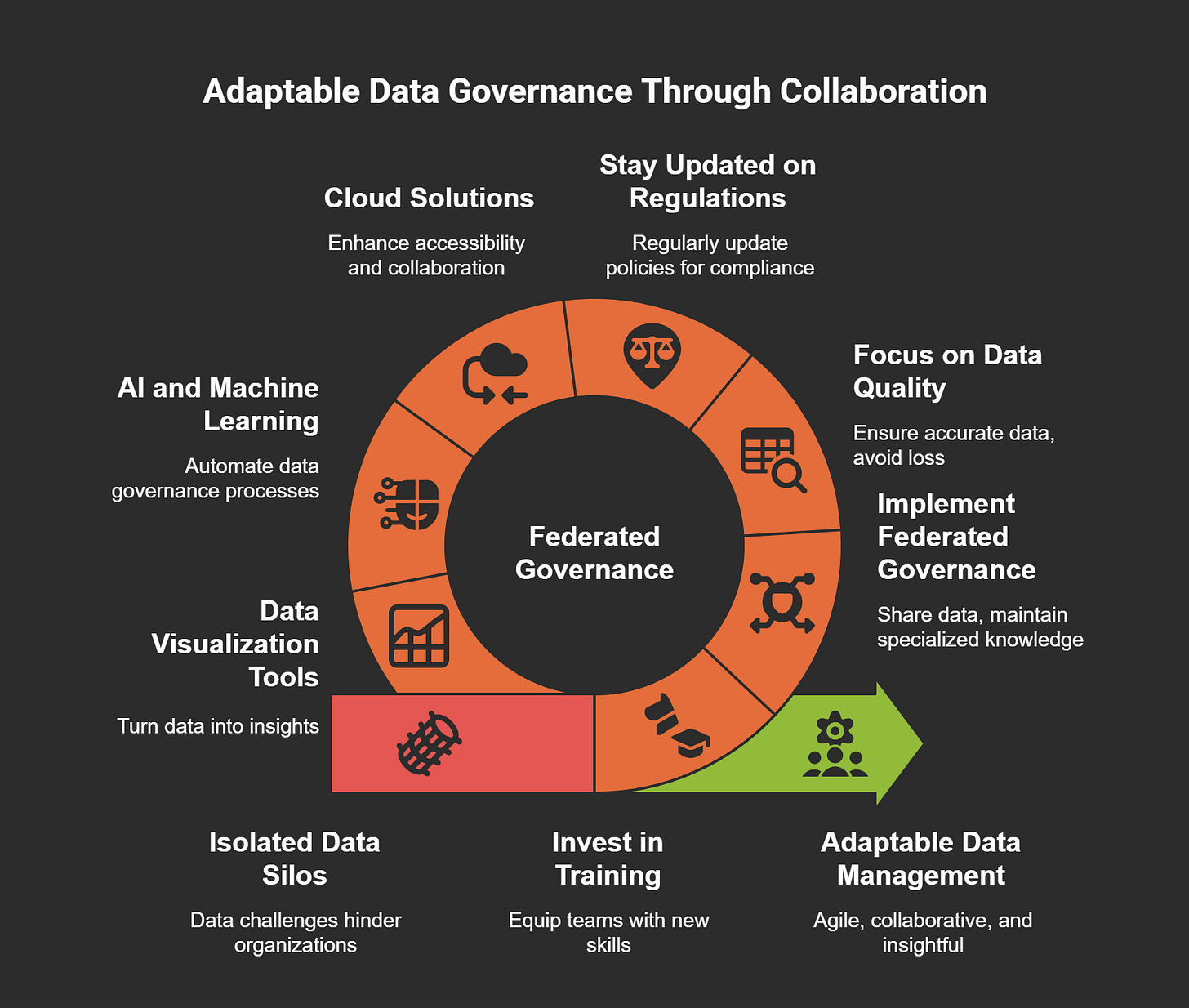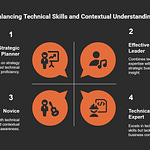Imagine being trapped in a room with your colleagues, each holding crucial pieces of information needed to solve a puzzle, but there are locked doors preventing you from sharing data. This scenario of a data silo escape room encapsulates the challenges many organizations face today in managing their data effectively. In this post, I’ll dive into how federated data governance can serve as the master key to unlock these doors and foster a culture of collaboration and efficiency in data management.
Understanding the Data Silo Reality
In today's fast-paced business world, organizations face significant challenges in managing their data effectively. It’s almost like being trapped in a maze, with each department holding onto their own secrets. Imagine this: the marketing team is locked in a room, clutching valuable insights about customer engagement. Meanwhile, the finance department is in another chamber, hoarding revenue figures. This image of departments as locked chambers is a perfect metaphor for the reality of data silos.
Data Management Challenges in Organizations
Organizations struggle with data management for several reasons:
Isolation of information: Departments often operate independently, leading to fragmented data.
Lack of collaboration: Teams miss out on opportunities to share insights and improve decision-making.
Inconsistent data quality: Poor data can lead to misguided strategies and wasted resources.
We can think of data as a puzzle. Each department holds a piece, but without sharing, the picture remains incomplete. This isolation can result in stagnant projects and missed growth opportunities.
The Impact of Isolated Data on Decision-Making
When teams operate in silos, decision-making can suffer. Consider this:
Marketing may miss trends in product usage because they don’t have access to operational metrics.
Finance struggles to forecast revenues accurately without insights into customer satisfaction.
Product development lacks feedback from marketing, leading to products that miss the mark.
What happens when you mimic a data escape room? You end up making decisions based on incomplete information. This can lead to costly errors and missed opportunities.
Real-World Consequences of Data Silos
The consequences of these isolated data chambers are profound. Research shows that organizations can lose 20-30% of their revenue annually due to poor data quality. Yes, you read that right—those are staggering numbers! A typical Fortune 1000 company could potentially gain $65 million from just a slight improvement in data accessibility.
It’s hard to imagine leaving that kind of money on the table, isn't it?
Statistics on Revenue Loss Due to Poor Data Management
The statistics speak for themselves. Consider these points:
Organizations lose significant revenue because they fail to utilize their data effectively.
Many companies struggle to adapt to the complex data landscape, leading to further disconnection.
In essence, poor data management is not just a technical issue; it’s a business risk. As the saying goes,
“Data is the new oil, but many organizations are still drilling in separate wells.”
This quote perfectly encapsulates the current state of affairs. Without proper governance and sharing protocols, organizations are merely wasting their resources.
Visualizing Departments as Locked Chambers
Picture those locked chambers again. Each team has critical information that could enhance their performance and drive success. Yet, they remain isolated. How do we break down these walls? It starts with recognizing that we need to unlock the doors between these chambers.
Imagine if Sarah, the data analyst in marketing, could easily access the operational metrics from Miguel in operations. Or if Priya in finance had the product usage data from Alex in product development. The potential for synergy is immense!
The Path Forward: Unlocking Data Silos
To move towards a more connected data landscape, organizations must embrace innovative data governance strategies. This means:
Establishing clear protocols for data sharing.
Encouraging collaboration between departments.
Investing in technologies that facilitate data access and integration.
It's time to break free from the constraints of data silos. Together, we can unlock the potential hidden in our data and drive our organizations towards greater success. The journey starts with recognizing the problem and taking the first steps toward a more connected future.
Building Bridges: The Role of Federated Data Governance
In today’s fast-paced digital world, organizations are often bogged down by a maze of isolated data silos. Imagine a scenario where three data scientists, two analysts, and a business manager are trapped in separate chambers of a data escape room. Each holds pieces of a complex puzzle, but they can’t collaborate to solve it. This scenario mirrors how many businesses manage their data today. So, what can we do about it? The answer lies in the innovative concept of federated data governance.
Definition of Federated Data Governance
Federated data governance is a framework that allows different departments within an organization to maintain control over their own data while promoting sharing and collaboration across the organization. It’s like having a master key that unlocks the doors to various chambers, enabling the flow of information without sacrificing the integrity of each department’s specialized knowledge.
Interconnecting Silos While Preserving Structure
One of the key features of federated governance is its ability to interconnect silos. Think of it as a bridge that links separate islands of information. Instead of forcing all data into a single central repository, federated governance allows departments to retain their unique systems while enabling access to each other's data. This approach maintains the structure and nuances of specialized data while fostering collaboration.
Benefits of Implementing Federated Governance Systems
So, why should organizations consider federated data governance? Here are some compelling reasons:
Enhanced Collaboration: Departments can share insights without losing their operational autonomy. This collaborative spirit can lead to breakthrough innovations.
Improved Data Quality: By allowing departments to manage their own data, organizations reduce errors that arise from manual data handling. A well-oiled federated system can improve insight and reduce time to information.
Cost Efficiency: Organizations can save on costs associated with maintaining a centralized data system. With federated governance, each department can optimize its resources according to its specific needs.
Greater Flexibility: The federated approach allows for rapid adaptation to changes in technology or business needs, making it easier to implement new tools or processes.
Real-Life Examples of Successful Data Governance Implementation
Many organizations have already reaped the benefits of federated governance. For instance, a well-known retail chain adopted this model to enhance its customer data management. By allowing its marketing, sales, and logistics departments to share insights while maintaining their own data systems, the company significantly improved customer satisfaction and operational efficiency. This real-world example demonstrates that when departments work together, they can create a more seamless experience for customers.
Challenges Organizations May Face
Of course, implementing federated governance is not without its challenges. Here are a few hurdles organizations might encounter:
Cultural Resistance: Some teams may be hesitant to share their data, fearing a loss of control. Building a culture that values collaboration is essential.
Establishing Clear Guidelines: Without clear data contracts and governance principles, miscommunication can arise. Organizations need to develop formal agreements that clarify what data is shared and how.
Metadata Management: Properly managing metadata is crucial. It serves as the map that helps teams navigate the data landscape. If departments neglect this aspect, confusion can ensue.
As I think about these challenges, I realize that the success of federated data governance relies heavily on strong leadership and clear communication. A Data Governance Council can act as the architects of this framework, aligning teams around shared objectives, while respecting the unique needs of each department.
Ultimately, federated data governance offers organizations a pathway to break down silos and foster collaboration. By enabling teams to share information more fluidly, organizations can unlock opportunities that were previously unimaginable. Just imagine the possibilities when departments can work together, leveraging their unique insights to drive innovation and growth.
From Siloed Systems to Synergized Solutions: A Case Study
In today’s fast-paced business world, the ability to access and analyze data quickly can make or break an organization. Yet, many companies remain stuck in a quagmire of isolated data silos. Picture this: teams are like puzzle pieces scattered across a table, each holding a part of the picture but unable to see how they fit together. This is where the concept of federated governance comes into play, acting as the glue that binds these pieces into a cohesive whole.
Analyzing a Success Story of Federated Governance
Let’s take a look at a compelling case study that illustrates the transformation through federated governance. Company A was drowning in disjointed data. Departments operated like separate islands, each with their own systems and processes. After implementing a federated governance model, they witnessed a staggering 25% faster decision-making. Imagine the ripple effect of that speed! Decisions that once took weeks were now made in days, or even hours.
Before: Teams were often left waiting for data, causing delays in project launches.
After: Teams had quick access to the information they needed, allowing for rapid adjustments and data-driven decisions.
Significant Changes Observed in Data Flow
The change in data flow was nothing short of revolutionary. Previously, data was like water stuck in a clogged pipe—hardly moving and often contaminated by misinformation. With the federated model, data flowed freely between departments, akin to a well-oiled machine. This transparency led to a sharp increase in collaboration.
For instance, the marketing team could now access real-time customer engagement metrics, while finance had visibility into product usage trends. This level of access not only improved their individual strategies but also fostered a culture of cooperation. As I often say,
“Collaboration shouldn’t be a luxury; it should be a necessity, especially in data management.”
Impact on Decision Making and Organizational Strategy
The impact on decision-making was profound. With data flowing seamlessly, leaders could make informed choices based on comprehensive insights. In the case of Company B, this shift resulted in an impressive 15% increase in revenue. It's fascinating how improved data flow can lead to such tangible results.
Furthermore, the organization’s overall strategy became more aligned. Instead of each department pursuing its own agenda, there was a unified vision. This collective approach allowed them to tackle challenges more effectively and innovate in ways they hadn’t thought possible.
Lessons Learned from Implementations
Every transformation comes with its lessons. One key take-away from these implementations is the importance of having data stewards within each department. These stewards act as navigators, ensuring that data flows correctly and efficiently. They understand not just the technical aspects of data governance, but also the unique needs of their respective teams.
Another crucial lesson is the necessity of establishing clear data contracts. These contracts outline how data will be shared and used, reducing the chances of miscommunication. Just like in any partnership, having clear guidelines fosters trust and accountability.
Future Implications for Other Companies
So, what does this mean for other organizations? The future looks promising for those willing to embrace federated governance. Companies that have recognized the value of breaking down silos are setting themselves up for success. They’re not just enhancing their data strategies—they’re fostering a culture of collaboration and innovation.
As more businesses adopt this model, we can expect to see a shift in how data is perceived. No longer will it be seen as a byproduct of operations; instead, it will become a vital asset that drives strategic decision-making. This shift can significantly impact the bottom line, leading to enhanced customer experiences and increased profitability.
In conclusion, the journey from siloed systems to synergized solutions isn’t just a dream; it’s a reality for many organizations that are willing to take the leap. By analyzing successful case studies and understanding the positive changes in data flow, decision-making, and culture, other companies can find a roadmap for their own transformations. The future of data management is bright, and it’s time to unlock those silos for good.
Overcoming Legacy Barriers in Data Management
In today's fast-paced world, data is everything. Yet, many organizations find themselves tangled in the confusing web of outdated data systems. Have you ever felt like you're trapped in a maze, where every turn leads to another dead end? This is often the reality for companies relying on legacy systems. They face numerous barriers that hinder their growth and efficiency. So, how do we overcome these obstacles?
Identifying Barriers Created by Outdated Data Systems
First, we need to recognize the barriers that legacy systems create. Here are the key issues:
Data Silos: Departments hoarding data instead of sharing it can lead to a lack of collaboration.
Poor Integration: Old systems often don’t communicate well with newer applications, leading to inefficiencies.
High Maintenance Costs: Maintaining outdated systems can drain resources. Did you know one company spent a staggering $300 million just to keep redundant systems running?
Limited Flexibility: Legacy systems can be rigid, making it difficult to adapt to changing business needs.
These barriers can lead to a frustrating experience for employees. Imagine trying to solve a puzzle with missing pieces. It’s tough, right? That's how many teams feel when they can't access the data they need.
Strategies for Breaking Down These Barriers
Now that we’ve identified the barriers, let’s explore some strategies to break them down:
Conduct an Audit: Assess your current data landscape. Identify what data you have, where it’s located, and how it's being used.
Foster a Culture of Collaboration: Encourage teams to share insights and data. Create incentives for collaboration.
Invest in Modern Solutions: Transition to cloud-based systems that allow for better integration and flexibility.
Implement Data Governance: Establish clear policies for data access and sharing. This ensures everyone understands how to manage and use data effectively.
By taking these steps, organizations can start to dismantle the barriers created by outdated systems and pave the way for more agile operations.
The Emotional and Operational Costs of Legacy Systems
We cannot overlook the emotional toll that these legacy systems take on employees. When people feel frustrated by their tools, it impacts their morale and productivity. For many, it's like running a marathon with heavy weights strapped to their backs.
On an operational level, legacy systems can lead to significant costs. Studies estimate that around 73% of organizational data goes unused. That's a staggering amount of wasted potential! Imagine the insights and innovations that could arise if this data were accessible and actionable.
"The real cost of legacy systems isn't just in dollars spent, but in missed opportunities."
When organizations cling to outdated systems, they risk falling behind their competitors who are leveraging modern technologies. It’s a dangerous game.
Transitioning to Modern, Flexible Data Architecture
So, how do we make the leap from legacy systems to modern data architecture? Here are some steps to consider:
Start Small: Transitioning doesn’t have to happen overnight. Begin with pilot projects that can demonstrate value.
Focus on User Experience: Modern systems should be user-friendly. This encourages adoption and reduces resistance.
Leverage the Cloud: Cloud solutions often provide the flexibility and scalability that legacy systems lack.
Transitioning isn't just a technical shift; it’s a cultural one too. It requires buy-in from all levels of the organization. Everyone needs to understand the benefits of modern data management.
Tools and Technologies Enabling This Transition
Finally, let’s talk about the tools and technologies that can assist in this transition:
Data Integration Tools: These tools help link disparate data sources, making it easier to manage and access data.
Cloud Storage Solutions: Services like AWS or Google Cloud offer flexibility and scalability.
Data Governance Platforms: These help establish protocols for data usage and sharing.
By embracing these tools, organizations can not only ease their transition but also unlock new opportunities for growth and innovation.
In the end, overcoming legacy barriers is vital for any organization striving for success in today's data-driven landscape. Let’s take the first step towards breaking down these walls and paving the way for a more efficient, collaborative, and innovative future.
Innovation Through Information: The Future of Data Management
As I think about the future of data governance, I can’t help but feel a sense of urgency. The landscape is shifting rapidly. Organizations face a maze of data challenges, especially as they grapple with isolated data silos. It’s not just a technical issue; it’s a leadership hurdle that requires a fresh perspective.
1. Predicting the Future of Data Governance
So, what does the future hold? I believe it’s all about adaptability and collaboration. We’re moving toward a world where organizations must be agile. They need to respond quickly to changes in the marketplace. Imagine a team that can access the right data at the right time, breaking down barriers that once held them back. The quote resonates with me:
"The future of data governance is about adaptability and collaboration across all levels of an organization."
2. How Organizations Can Prepare for Upcoming Challenges
Organizations need to brace themselves for a wave of challenges. The key is preparation. Here are some strategies I think can help:
Invest in Training: Equip your teams with the skills they need to navigate new technologies.
Implement Federated Governance: This approach allows departments to maintain their specialized knowledge while still sharing data.
Focus on Data Quality: Poor data quality can lead to significant revenue loss. Ensuring your data is accurate is crucial.
Stay Updated on Regulations: Compliance is a moving target. Regularly update your policies to reflect new laws.
By taking these steps, organizations can not only prepare for the future but thrive in it. The data landscape is evolving, and those who adapt will lead the charge.
3. Balancing Specialization with Integration
One of the biggest challenges in data management is balancing specialization with integration. On one hand, departments need their unique systems tailored to their specific needs. On the other hand, these systems often create silos. How do we find that sweet spot?
I think the solution lies in a federated approach. It’s about creating a network where departments can share vital information without losing their specialized knowledge. This means empowering data stewards—individuals who understand both the operational metrics and governance principles within their domains. They become navigators, not gatekeepers.
4. Exploring Newer Technologies
New technologies are emerging every day. From cloud computing to advanced analytics tools, organizations have more options than ever. But how do we choose the right ones? I believe we should start small. Pilot new technologies in a controlled environment. This way, we can gauge their effectiveness before a full-scale rollout.
Cloud Solutions: These can enhance accessibility and collaboration across teams.
AI and Machine Learning: These technologies can help automate data governance, making it easier to manage.
Data Visualization Tools: They can turn complex data into understandable insights.
Exploring these newer technologies can give organizations a competitive edge. The faster we adapt, the more we can innovate.
5. The Expanding Role of AI in Data Governance
AI is becoming a game-changer in data governance. It can help organizations manage their data more effectively. Think about it: AI can analyze vast amounts of data, identify patterns, and even predict future trends. This not only saves time but also improves decision-making.
Furthermore, AI can enhance data quality. It can identify anomalies and flag potential issues before they escalate. This proactive approach can lead to more reliable data, which is essential for any organization looking to thrive.
As we integrate AI into our governance strategies, we must remember that human oversight is still critical. AI is a tool, not a replacement for human intuition and creativity.
In this ever-evolving landscape, we must remain vigilant and adaptable. The innovations in data governance are paving new pathways for organizations. By enhancing our federated governance strategies and embracing new technologies, we can unlock the potential of our data. The future is bright, and I’m excited to see where it leads us!
Recap & Final Thoughts: Breaking Free from the Escape Room
As we wrap up our exploration of data governance, I want to take a moment to reflect on the journey we've undertaken. Throughout this blog, we've navigated through the complex world of data management, focusing on the issue of data silos and their detrimental effects on organizations. It's been quite a ride, hasn't it?
Summarizing Key Points
First, let’s recap the key points we've discussed. We started by painting a vivid picture of data silos—the frustrating chambers where essential information is locked away. This metaphor illustrates how teams often operate in isolation, which leads to missed opportunities and inefficiencies. From marketing to finance, every department has valuable insights that, if shared, could unlock new levels of understanding and innovation.
The Importance of Breaking Down Data Silos
Next, we emphasized the importance of breaking down these data silos. Imagine trying to solve a puzzle with pieces scattered across different rooms. It’s impossible, right? That's exactly what happens when departments hoard data. Each team has crucial information that, when shared, can lead to breakthrough insights. We learned about federated data governance, a framework that acts as the master key to these isolated chambers, allowing data to flow freely among departments. This approach encourages collaboration while preserving the unique knowledge within each domain.
Final Thoughts on the Future of Data Governance
Now, what’s in store for the future of data governance? I believe we’re on the brink of a transformation. As organizations continue to embrace federated governance, they will move toward a more interconnected and collaborative data landscape. This shift won't just enhance data access; it will also foster a culture of innovation and agility. By empowering teams to share information while ensuring quality and context, we can create opportunities that were previously unimaginable in our data-driven world.
A Call to Action for Organizations
So, what should organizations do? The answer is simple: take action. Start small by identifying a critical domain within your organization. Engage potential data stewards who can navigate the complexities of your data landscape. Draft your first data contract and set clear guidelines for data sharing. These steps may seem small, but they can lead to significant changes over time. Remember, the path to improved data governance is a journey, not a sprint.
Encouraging Feedback and Discussion
Lastly, I encourage you to share your thoughts. Have you experienced the challenges of data silos in your organization? What strategies have you found effective in breaking these barriers down? Your feedback is invaluable as we collectively navigate this evolving landscape. Let’s keep the conversation going and learn from each other’s experiences.
Reflecting on our journey so far, it’s clear that the need for effective data governance is more pressing than ever. Organizations that embrace these new practices will not only survive but thrive in a data-driven world. Your escape from data silos starts today. Together, we can unlock the full potential of our data and drive our organizations toward success.
“Data is a precious thing and will last longer than the systems themselves.” – Tim Berners-Lee



